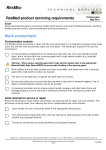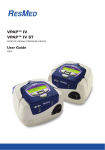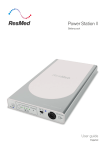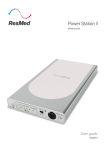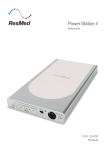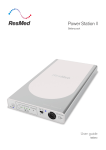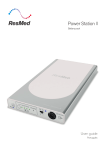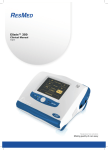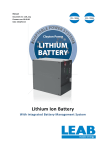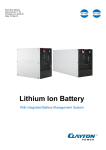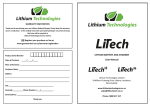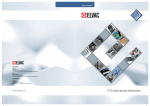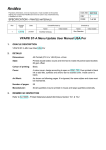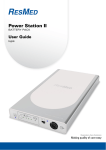Download 97 Waterloo Road North Ryde
Transcript
ResMed Power Station II (RPS II); Launch PRODUCT BULLETIN Bulletin Number: Month/Year: Distribution: Date of implementation: PB#678 April 2011 Asia Pacific Immediate General The ResMed Power Station II (RPS II) is ready for launch. The RPS II is an external lithium-ion battery pack. It is used to provide convenient power and backup power to ResMed ventilators and sleep devices running on 24V and 26V DC. The RPS II is ideal for travel or when additional mobility and freedom are required such as on the back of a wheelchair and during travel. The power capacity and operation time can be doubled by using two batteries, with an automatic transition from the primary to the secondary battery. How the RPS II works ResMed Power Station II is an external long-life, lithium-ion battery that simply works alongside ResMed ventilators or sleep therapy devices. Charging the battery You can charge one battery from 0% to greater than 95% in less than 4 hours. Power or backup power Using the appropriate DC cable you can connect the battery to a ResMed therapy device to provide power or backup power. When providing backup power to the DC inlet, the AC power cord connects the therapy device to the mains power outlet (available on devices with both AC and DC inputs). The voltage output selector on the RPS II rear panel lets you select the correct output voltage for your device (24V or 26V). Using two batteries—doubling capacity The two batteries sit neatly on top of each other. A Velcro™ strap is included in the coupler kit to hold them more securely if required. Both batteries can be charged together or used simultaneously to power a therapy device (via the coupler)—one battery serving as the primary power source, the other as the secondary/reserve. Provided in a practical bag An RPS II kit (24921) consists of one battery, a user guide, a PSU adapter to connect the power supply to the battery pack, and a convenient carry bag. The carry bag also has space for a second RPS II battery pack, DC cable and PSU with mains cable (to be ordered separately). ResMed Ltd 1 Elizabeth Macarthur Drive Bella Vista NSW 2153 Australia Tel: +61 2 88841000 Fax: +61 2 8884 2000 ABN 30 003 765 142 Global leaders in sleep and respiratory medicine www.resmed.com Marketing material RPS II fact sheets are available to order from the Australian Distribution Centre; the document number is 1014318. An RPS II web page is available on-line: www.resmed.com/rpsII Useful information RPS II battery capacity is 97 Wh, just below 100 Wh which is the present limit for bringing the batteries as hand luggage on board passenger aircrafts without notifying the carrier. However, we always advise the users to inform the air carrier before travelling. Alerts, indicators and power level LEDs are placed on a convenient front display together with the control buttons and connector. The front display of the Rest of World (ROW) RPS II has symbols only. RPS II has a switchable output between 24V and 26V. The switch is placed on the rear panel. Elisée 150 and VS III require 26V, all other devices require 24V. Different DC cables are available to connect the RPS II to the appropriate device. At launch, the User Guide for the ROW version will come with an insert with information about storage and correct DC output voltage & DC cables for every device platform. A new User Guide coming soon will have this information included. Document 1013434 ―Battery/device compatibility list‖ shows the RPS II’s compatibility with ResMed therapy devices with the corresponding battery run times. This document is available on www.resmed.com on the Products page under Service & Support. RPS II is using the same 90W PSU as the S9 platform; users with this 90 W PSU do not need an additional PSU. Using two RPS IIs: The Battery Coupler connects two RPS IIs to double the run time (autonomy) and has labeled cables to the two batteries. The primary battery is discharged first, then the secondary battery takes over and the primary can then be disconnected and recharged. Charging two RPS IIs: When charging two batteries simultaneously from one PSU using the Coupler Kit (24964), the charging time until both batteries are fully charged might be more than 4 hours. Each RPS II battery weighs 0.9 kg. Product codes RPS II kits (One kit contains: 1 x battery + 1 x User Guide + 1 x PSU Adapter + 1 x Carry Bag) 24921 ResMed Power Station II Battery Pack – ROW Additional items and accessories 24926 RPSII – Battery Only 24952 24959 RPSII - Carry Bag RPSII - DC Cable, VPAPIII ST-A, Stellar 150 24981 24960 RPSII - DC Cable, Stellar, 0,5m (for use in Stellar Mobility bag) RPSII - DC Cable, VPAP IV 24961 24962 RPSII - DC Cable, S9 Series RPSII - DC Cable, Eliseé 150 24963 24964 RPSII - DC Cable, VSIII RPSII - Battery Coupler Kit 36824 S9 PSU 90W PLUS ANZ PWR CORD Ordering information 1. 2. 3. Order the ResMed Power Station II Battery Pack kit (24921) Order the DC cable based on the specific ResMed ventilator or sleep device to be connected to the RPS II. For devices other than S9 (or if you want an additional PSU), order the correct S9 Power Supply Unit (PSU) from the list above. Optional: If two batteries are required, order an additional 'battery only' (24926) and a battery coupler kit (24964). ResMed Ltd 1 Elizabeth Macarthur Drive Bella Vista NSW 2153 Australia Tel: +61 2 88841000 Fax: +61 2 8884 2000 ABN 30 003 765 142 Global leaders in sleep and respiratory medicine www.resmed.com Compatibility and run times RPS II is compatible with: VPAP III ST-A, VPAP III ST-A with QuickNav, VPAP S, VPAP ST, VPAP IV, VPAP IV ST, S9-series, Stellar, VS III and Elisée 150. Run Times (as stated in the ―Battery/device compatibility list‖): Product Run Time (hours) VPAPIII ST-A and VPAPIII ST-A with QuickNav VPAP S, VPAP ST, VPAP IV, VPAP IV ST 6 9 S9 Series Stellar 13 8 VSIII (A)PCV Mode VSIII (A)CV Mode 7 4.5 Elisée 150 (A)PCV Mode Elisée 150 (A)CV Mode 6 4.5 Technical specifications Battery technology Lithium-ion Capacity UN classification 97 Wh UN3481 (lithium-ion batteries packed with equipment) Power supply Battery output voltage Power supply unit output current (rated) Battery output current (rated) Input range 100–240V, 50–60Hz, 1.0-1.5A Nominal for aircraft use 110V, 400Hz (24V / 26V) ± 0.5V, 90W continuous Standby current Protection < 100 μA Overcharge, over-discharge, excess current, short circuit, high temperature Dimensions (L x W x H) Battery weight 230 x 126 x 26 mm 0.9 kg System weight Minimum life cycle 2.3 kg ≥ 500 cycles at 23°C to 60% capacity Charging: 5°C to 40°C; 0–85% maximum humidity Discharging: -5°C to 40°C; 0–85% maximum humidity -20°C to +45°C; 85% maximum humidity 3.75A 3.75A / 3.46A Operating conditions Transport/storage conditions Operating/storage air pressure Recharge time IEC 60601-1 classification Electromagnetic compatibility 600 hPa to 1060 hPa < 4 hrs to >95% of full level Class II (double insulation) and/or Internally Powered Equipment, IPX1 (IPX0 while charging). (See further User manual or www.resmed.com) Product complies with all applicable electromagnetic compatibility requirements (EMC) according to IEC60601-1-2. (See further User manual or www.resmed.com) ResMed Ltd 1 Elizabeth Macarthur Drive Bella Vista NSW 2153 Australia Tel: +61 2 88841000 Fax: +61 2 8884 2000 ABN 30 003 765 142 Global leaders in sleep and respiratory medicine www.resmed.com Service and Maintenance The RPS II is intended to provide safe and reliable operation when used and maintained in accordance with the instructions provided by ResMed. There is no servicing necessary during the lifetime of the battery. The service life of the RPS II exceeds 500 recharge cycles. After this cycle, the battery will last about 60% of the time from its original condition. Cleaning recommendations are provided in the User Guide. Some countries require all medical equipment to have a periodic service to confirm that the equipment is in good working order. Section 3 of the Service manual, ―General inspection procedures‖ may be used in this situation. If the RPS II needs to be returned to a ResMed Service Centre, complete the ResMed Service Request Report found in ―Appendix A‖ of the Service manual. Send the completed form along with the RPS II to your ResMed office. For more details about service and maintenance, see the Service manual, document number 248441. Storage Batteries must be charged to 50% indicated by two green LEDs and switched off before storing. You must recharge the batteries to 50% again after three months of storage. When not in use, all Lithium-Ion batteries self-discharge over time. If not periodically recharged (i.e. every three months), the RPS II will eventually self-discharge to the point that it can no longer be recharged. If this occurs the RPS II is no longer usable and is unrecoverable. Note: A fully charged battery when left switched on self-discharges to less than 50% of full capacity within two weeks of storage. Once switched off, the battery self-discharges to less than 50% of full capacity within one month of storage. For further information, please contact your nearest ResMed office. See www.resmed.com for details. © 2011 ResMed Ltd. 104552/1 2011 05 ResMed Ltd 1 Elizabeth Macarthur Drive Bella Vista NSW 2153 Australia Tel: +61 2 88841000 Fax: +61 2 8884 2000 ABN 30 003 765 142 Global leaders in sleep and respiratory medicine www.resmed.com




